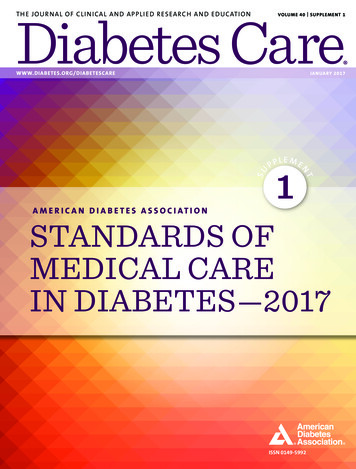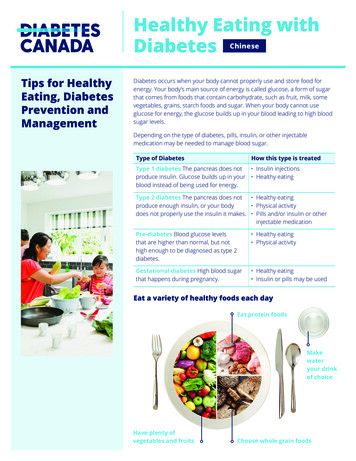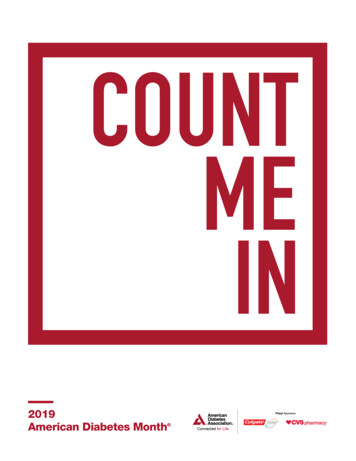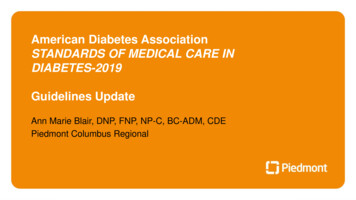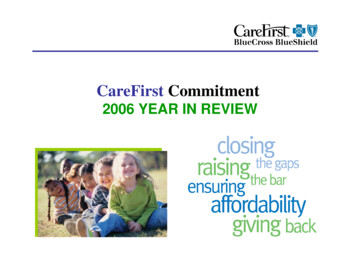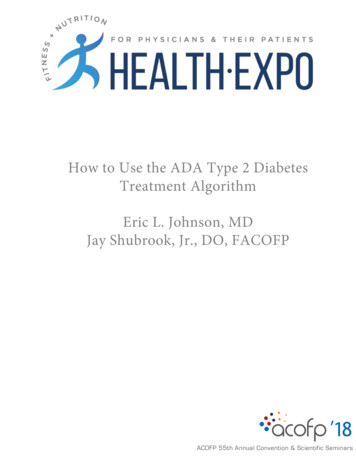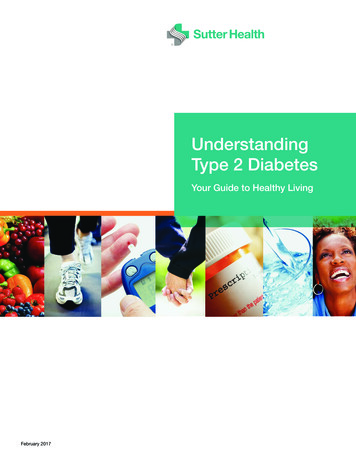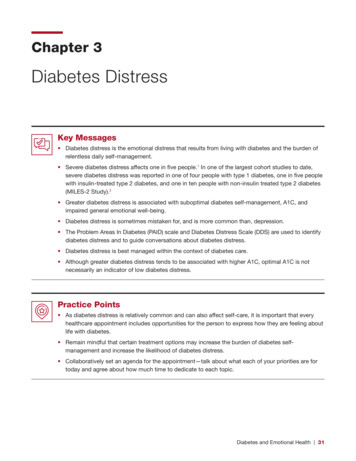
Transcription
Chapter 3Diabetes DistressKey Messages Diabetes distress is the emotional distress that results from living with diabetes and the burden ofrelentless daily self-management. Severe diabetes distress affects one in five people.1 In one of the largest cohort studies to date,severe diabetes distress was reported in one of four people with type 1 diabetes, one in five peoplewith insulin-treated type 2 diabetes, and one in ten people with non-insulin treated type 2 diabetes(MILES-2 Study).2 Greater diabetes distress is associated with suboptimal diabetes self-management, A1C, andimpaired general emotional well-being. Diabetes distress is sometimes mistaken for, and is more common than, depression. The Problem Areas In Diabetes (PAID) scale and Diabetes Distress Scale (DDS) are used to identifydiabetes distress and to guide conversations about diabetes distress. Diabetes distress is best managed within the context of diabetes care. Although greater diabetes distress tends to be associated with higher A1C, optimal A1C is notnecessarily an indicator of low diabetes distress.Practice Points As diabetes distress is relatively common and can also affect self-care, it is important that everyhealthcare appointment includes opportunities for the person to express how they are feeling aboutlife with diabetes. Remain mindful that certain treatment options may increase the burden of diabetes selfmanagement and increase the likelihood of diabetes distress. Collaboratively set an agenda for the appointment—talk about what each of your priorities are fortoday and agree about how much time to dedicate to each topic.Diabetes and Emotional Health 31
DIABETES DISTRESSHow Common Is Diabetes Distress?Evidence from 50 studies across the world tells us that one in four people with type 1 and 2 diabetes have high levels ofdiabetes distress that is likely to be negatively affecting how they manage their diabetes.1Type 1 diabetesa,2Type 2 diabetes (insulin)a,2Type 2 diabetes (no insulin)a,2WHAT ISDiabetes Distress?Diabetes distress (also known as “diabetes-specificdistress” or “diabetes-related distress”) is the emotionalresponse to living with diabetes, the burden of relentlessdaily self-management, and (the prospect of) its longterm complications.3–5 It can also arise from the socialimpact of diabetes (e.g., stigma, discrimination, ordealing with other people’s unhelpful reactions or theirlack of understanding)6,7 and the financial implications(e.g., insurance and treatment costs) of the condition.3,8Diabetes distress occurs on a continuum defined byits content and severity.3 This emotional distress, to agreater or lesser degree, is part of having to live with andmanage diabetes. It can fluctuate over time and maypeak during challenging periods; for example, soon afterdiagnosis, during major changes in treatment regimen,or at diagnosis/worsening of long-term complications.It can also peak at times of heightened general stress,when the added burden of diabetes self-care becomestoo much.9 The extent to which diabetes distress isstable or changes over time varies depending on thesource of the distress.10 If left untreated, mild diabetesdistress often persists11 and may develop into severediabetes distress and/or depression10 (see Chapter 6).Living with diabetes is challenging. The most frequentlyreported problem areas among people with type 1 andtype 2 diabetes are “worrying about the future and thepossibility of serious complications” and “experiencingfeelings of guilt and anxiety when diabetes managementgoes off track.”12,13 Although there are common stressorsregardless of the type of diabetes, distress can differby diabetes type (e.g., for type 1 diabetes more oftenrelated to insulin treatment and hyper/hypoglycemia;for type 2 diabetes more often related to socialconsequences, food restriction, and obesity).14The impact of these diabetes-related feelings shouldnot be underestimated. Managing diabetes is a“24/7” activity, involving the continual need to makedecisions, and take actions, with often unexpectedand unsatisfactory outcomes. Doing everything “asrecommended” is no guarantee of stable blood glucoselevels—doing exactly the same things today as theday before can result in very different outcomes. Theaccumulation of these problems and frustrationsmay lead to “diabetes burnout” (see Box 3.1) anddisengagement from diabetes care.Diabetes distress involves emotional symptoms thatoverlap with several recognized mental health conditions,such as depression (see Chapter 6 and Box 6.2).3,5Despite their similarities, depression and diabetes distressare different constructs and require different assessmentand management strategies. Unlike major depression,diabetes distress does not assume psychopathology—itis an expected reaction to diabetes, whereas depressionrefers to how people feel about their life in general.4Greater diabetes distress is associated with adversemedical and psychological outcomes, including:› suboptimal self-management (e.g., reduced physicalactivity, less healthy eating, not taking medication asrecommended, and less frequent self-monitoring ofblood glucose)15–20› elevated A1C19,21–26› more frequent severe hypoglycemia15,27› and impaired quality of life.16,28a 28%, 20%, and 11% had severe diabetes distress (PAID total score 40) respectively. Data based on the Diabetes MILES-2 report.232 Diabetes and Emotional Health
DIABETES DISTRESSBOX 3.1Diabetes BurnoutDiabetes burnout is a state of physical or emotional exhaustion caused by the continuous distress of diabetes(and efforts to self-manage it).29,30 Typically, the individual feels that despite their best efforts, their blood glucoselevels are unpredictable and disappointing. People with diabetes describe it as feeling “detached” from theirdiabetes care, combined with a sense of “powerlessness.”31People with diabetes burnout “can’t be bothered” with the continual effort required to manage diabetes. Thisstate of mind can be temporary, or it may be ongoing. These individuals are sometimes described by healthprofessionals as being “difficult,” “non-compliant,” or “unmotivated,”32,33 while they are actually struggling withthe relentlessness of managing a lifelong condition.Signs of diabetes burnout include:› disengagement from self-care tasks (e.g., skipping insulin doses or not monitoring blood glucose)› unhealthy or uncontrolled eating› risk-taking behaviors› or non-attendance at clinic appointments.People with diabetes burnout understand the importance of diabetes self-management for their future health butfeel unable to engage with management of their diabetes. If and when someone with diabetes burnout attendstheir appointment, they are rarely open to any advice for change that you may offer: “I’ve tried that before, butit didn’t work”; “I stopped doing finger-pricks because I know my blood sugar will be too high anyway.” Thisdisengagement from self-care can increase their fears of developing long-term complications and sense ofpowerlessness to take control. As clinical psychologist, Dr. William Polonsky, describes, “they are at war withtheir diabetes—and they are losing it.”29,*Diabetes burnout can co-occur with depression (see Chapter 6), anxiety (see Chapter 7), and negative mood. Incontrast to diabetes distress, very little research has been conducted specifically about diabetes burnout.30,34The best way to prevent diabetes burnout is to regularly monitor for diabetes distress so that you can offertimely assistance to address concerns as they arise.*Dr. Polonsky’s book, Diabetes Burnout: What to Do When You Can’t Take It Anymore, is a helpful resource for people with diabetes, butalso for diabetes health professionals; it provides realistic and clear insight into what diabetes burnout is and how it can be treated.Diabetes and Emotional Health 33
DIABETES DISTRESS7 A’s Model: Diabetes DistressThis dynamic model describes a seven-step process that can be applied in clinical practice.The model consists of two phases: How can I identify diabetes distress? How can I support a person who experiences diabetes distress?Apply the model flexibly as part of a person-centered approach to care.ARRANGEfollow-upcareASSIST withdevelopingan achievableaction planArrangeAssistAwareAssignBe AWARE thatpeople with diabetesmay experiencediabetes distressAskASK aboutdiabetesdistressASSIGN to anotherhealth professionalADVISEabout diabetesdistressAdviseAssessASSESS fordiabetes distressusing a validatedquestionnaireHOW CAN I IDENTIFYDiabetes Distress?Be AWAREDiabetes distress can present itself in many ways. Somecommon signs to look for include:› suboptimal A1C or unstable blood glucose levels› not attending clinic appointments› reduced engagement with diabetes self-care tasks(e.g., less frequent monitoring of blood glucose orskipping medication doses)34 Diabetes and Emotional Health› ineffective coping strategies for dealing with stress(e.g., emotional eating)› multiple negative life stressors or chronic stressdistinct from diabetes (e.g., financial problems,unemployment, or homelessness)› impaired relationships with health professionals,partners, family, or friends› or appearing passive or aggressive during medicalappointments.
DIABETES DISTRESSEven if A1C or blood glucose levels are withintarget, this does not mean that the personis free of diabetes distress. Achieving thesetargets may require intensive efforts thatare potentially affecting other areas of theirlife (e.g., social activities and quality of life)and are unsustainable. Remain mindful thatrecommending changes to diabetes selfmanagement (e.g., recommending morefrequent blood glucose monitoring) mayincrease the burden of diabetes and, thereby,has the potential to increase diabetes distress.ASKIt is advisable that you ask about diabetes distress on aroutine basis, as part of your person-centered medicalappointments, to explore the impact of diabetes on theperson’s daily life and well-being.Ask open-ended questions. You can preface these byacknowledging the expected daily challenges of livingwith diabetes, for example, “Many people that I seefeel that living with diabetes is quite challenging.” This“normalizes” diabetes distress.There are many ways you can ask about diabetesdistress;8 choose an approach that you find mostcomfortable and one that best suits the person withdiabetes. Here are some examples of open-endedquestions you could use:› “What is the most difficult part of living with diabetesfor you?”35› “What are your greatest concerns about yourdiabetes?35› “How is your diabetes getting in the way of otherthings in your life right now?”These questions offer the person an opportunity to:› raise any difficulties (emotional, behavioral, or social)that they are facingabout what you and I can do to reduce your distress.What do you think?”Additional Considerations› People may not expect to be asked about theiremotions during a diabetes appointment. A distinctdisconnect between you and the person withdiabetes may be an indication of diabetes distress.For example, the person may not be listening to whatyou say or may reject your suggestions for changesto their diabetes management plan or lifestyle. Also,look out for people who regularly skip or do notattend their appointments.› People with diabetes may not be aware of diabetesdistress and may interpret their experiences asdepression.› Diabetes distress fluctuates over time. A personmay not be experiencing diabetes distress todaybut they may be the next time you see them. Lifecircumstances can change quickly, and stressors(diabetes-related or not) may disrupt blood glucoselevels or self-care behaviors and worsen diabetesdistress. Therefore, at every appointment, it is alwaysa good idea to ask the person how they are doingwith their diabetes.If the person indicates that they are experiencingconcerns or distress about diabetes, you maywant to explore this further (see ASSESS). Using avalidated questionnaire will help you both get a betterunderstanding of the specific problems the person isfacing. Importantly, it will also give you a benchmark fortracking the person’s distress over time.However, only use a questionnaire if there is timeduring the appointment to talk about the scores anddiscuss with the person what needs to happen in orderto address the identified “problems.” For informationabout using questionnaires in clinical practice, seepages 10 and 11.› and express how particular diabetes-related issuesare causing them distress and interfering with theirself-care and/or their life in general.Validated QuestionnairesOne example of how to follow up the conversationcould be: “It sounds like you’re having a difficult timewith your diabetes. The problems you describe are quitecommon. And, as you also said, they often have a bigimpact on how you feel and how you take care of yourdiabetes. If you like, we could take some time to talkThe Problem Areas In Diabetes (PAID) is a 20-itemquestionnaire, widely used to assess diabetesdistress.36 A copy is included on page 44. Each item ismeasured on a five-point scale, from 0 (not a problem)to 4 (a serious problem). The scores for each itemare summed, then multiplied by 1.25 to generate aASSESSDiabetes and Emotional Health 35
DIABETES DISTRESStotal score out of 100; with total scores of 40 or moreindicating severe diabetes distress.13 Apart from thetotal score, an individual item score of 3 or moreindicates a “problem area” or concern and should befurther explored in the conversation.Another widely used questionnaire for diabetes distressis the Diabetes Distress Scale (DDS), which has 17items.6 A version of the DDS specifically designed forpeople with type 1 diabetes (T1-DDS) has also beenvalidated in the U.S. and Canada.8 A copy of each scaleis included on pages 46–48. Each item is measuredon a six-point scale, from 1 (not a problem) to 6 (avery serious problem). Scores on individual items areaveraged within subscales (sources of distress) and atotal score; with scores of 2–2.9 indicating moderatedistress, and scores of 3.0 or greater indicating severediabetes distress.37To follow up on the completion of the PAID or DDS youmay want to ask:› “How did you feel about answering these questions?”› “When looking at your scores, does anything standout for you?”Not all stressors that can lead todiabetes distress are addressed in theexisting validated questionnaires, andtherefore exploration through openended questions is recommended(see ASK) to identify other causes ofdiabetes distress.36 Diabetes and Emotional HealthAdditional ConsiderationsNo Diabetes Distress—What Else Might Be Happening?› If the person’s responses to the questionnaire donot indicate the presence of diabetes distress,this may be because they are reluctant to openup about their distress or may feel uncomfortabledisclosing to you that they are not “on top” oftheir diabetes.Therefore, a very low score does not necessarilymean that the person is not experiencing diabetesdistress. It may be that they are not yet ready toshare that experience with you. It may take time forthem to express their diabetes-related concernsand problems—or they may feel more comfortabletalking about it with someone else. Acknowledgingthat many people experience difficulties and distressin managing their condition on a daily basis can beone way to show your support and openness to talkabout their concerns; they may be ready to talk atfuture appointments.› If not diabetes distress, consider other psychologicalproblems, for example, depression (see Chapter 6),anxiety (see Chapter 7), or general psychologicaldistress. Using a general psychological distressquestionnaire (such as the Kessler-10)38 could beinformative in this instance, as the person may beexperiencing other life stressors that are causinggeneral distress and affecting their diabetes selfmanagement and outcomes. Explaining andnormalizing diabetes distress is the first step toaddressing it (see ADVISE).
DIABETES DISTRESSHOW CAN I SUPPORT A PERSONWho Experiences Diabetes Distress?ADVISENow that you have identified what is causing the person’sdiabetes distress, you can advise them on the options forthe next steps and then, together, decide on an action plan.When using the PAID or DDS, the scores on the individualitems are a useful first indication of the major problem(s) orconcerns for the person and will guide the conversation.› There will be occasions when you will need to referthe person to another health professional. This willdepend on: the needs and preferences of the person withdiabetes your knowledge, skills, and confidence toaddress the problem area(s)Explain what diabetes distress is and that many peoplewith diabetes experience it: the severity of the diabetes distress, and thespecific problem(s) identified› Explain the signs and consequences of diabetesdistress (e.g., the impact on their daily selfmanagement and well-being). whether it is combined with other significant lifestressors› Acknowledge the significant daily efforts required tomanage diabetes—this by itself may reduce the distress.› “Normalize” negative emotions about diabetes.› If a person is self-blaming (e.g., “I am useless,”or “I can never get it right”), explain that diabetesoutcomes are not a reflection of who they are as aperson; diabetes is not about being “good” or “bad”or “a failure.”32,33 Instead remind them that diabetescan be difficult to manage, so focusing on what theyare doing well, despite less-than-ideal outcomes, issometimes “good enough.”› Offer the person opportunities to ask questions aboutwhat you just discussed.› Make a joint plan about the “next steps” (e.g., whatneeds to be achieved to reduce diabetes distress andthe support they may need).NEXT STEPS: ASSIST OR ASSIGN?› People with diabetes who experiencepsychological problems often prefer to talk aboutthis with their diabetes health professionals ortheir primary care provider (PCP) rather than witha mental health specialist.39› As diabetes distress is so common and intertwinedwith diabetes management, it is best addressed bya diabetes health professional (or the PCP, if they arethe main health professional). If you have the skillsand confidence, support the person yourself, as theyhave confided in you for a reason. A collaborativerelationship with a trusted health professional andcontinuity of care are important in this process.3 whether other psychological problems are alsopresent, such as depression (see Chapter 6) oranxiety (see Chapter 7) and your scope of practice, and whetheryou have the time and resources to offer anappropriate level of support.› If you believe referral to another health professionalis needed: explain your reasons (e.g., what the other healthprofessional can offer that you cannot) ask the person how they feel about yoursuggestion and discuss what they want to gain from thereferral, as this will influence to whom thereferral will be made.ASSISTExplore the most appropriate support for theindividual, for example, diabetes educationor revising their management plan; advice onlifestyle changes; emotional or social support; or acombination of these.Practical strategies for assisting a person withdiabetes distress are detailed in Appendix C. Thestrategies are based on clinical experience, expertise,and evidence.9,40,41 Not all will suit everyone, so youwill need to work with the person to tailor an actionplan to meet their specific concerns, needs, andpreferences. Discussing the individual’s responsesto the PAID or DDS (see ASSESS) is useful for thispurpose. If multiple stressors are identified, prioritizetheir most important or burdensome issues.Diabetes and Emotional Health 37
DIABETES DISTRESSYou might ask questions to inform the action plan, such as:› “It sounds like you are struggling with several aspectsof your diabetes care. Which of these would you mostlike to talk about today?”› “You said you feel angry and guilty when you thinkabout your diabetes. Could you tell me what exactlymakes you feel this way?” Explore whether it is theself-management tasks or the diabetes outcomes(e.g., high blood glucose levels) leading to thesefeelings, or whether it is related to how diabetesaffects other aspects of their life (e.g., feelings ofnot being a “good” parent because of diabetes, ordiabetes interfering with their work or social life).› “You have indicated that you are concerned aboutdeveloping complications. Could you tell me a bitmore about your concerns?” The person’s responsewill help you to identify unrealistic concerns soyou can provide personalized information abouttheir actual risk and preventative actions. It willgive you a better understanding of the person’sspecific concerns, for example, whether theirconcerns relate to the risk of vision impairment,problems with their feet, or other complications.Many people with diabetes overestimate their riskof complications and feel helpless to prevent them.This causes significant distress and can lead todisengagement with their self-care.› “According to your responses, you feel supportedin some aspects of your diabetes management butnot in others, is that correct? Can you give me anexample of this?”› “You feel that you are not getting support from yourpartner or family/friends. Is this your overall feeling?”Additional Considerations› Reflect on aspects that are going well, tocounterbalance “problems.” Many of ourconversations focus on problems and problem solving.However, it is just as crucial to explore what is goingwell; that is, in what aspect(s) of diabetes managementdoes the person feel confident? This will highlight theirstrengths and skills, which could be applied to addresstheir current problems.› Agree on an agenda for the appointment. Agreewith the person about the time dedicated to talkabout their concerns and the issues you both wouldlike to address today. In practice, there is usually a bigoverlap between both agendas, but it is important notto assume this is the case. If there is insufficient timeto cover everything, suggest a follow-up appointment38 Diabetes and Emotional Healthwith you or someone else on your team who couldprovide the additional support.› Stay open to the idea that people with diabetescan have safe, planned breaks from their usualdiabetes management (see Box 3.2).› If the diabetes distress persists, a moreintensive approach may be needed. Althoughdiabetes distress is best addressed during routineappointments, if the person shows no improvementit may be necessary to: reconsider referring the person to a mental healthprofessional and assess whether there are additional or otherunderlying psychological problems, for example,depression (see Chapter 6) or anxiety (seeChapter 7).Taking a Safe Breakfrom DiabetesBOX 3.2It is unrealistic to expect people with diabetesto monitor their health vigilantly 24 hours aday, seven days a week. As this guide outlines,lack of motivation due to diabetes distressand/ or depression can have serious negativeconsequences for a person’s health. People soinclined will take breaks from actively managingtheir diabetes with or without your support.Enabling them the freedom to take short breaksevery now and then will increase their chances ofmaintaining motivation to take good care of theirhealth in the long-term.Where Do I Start?Work with the person to meet their needs.Remember to put yourself in their shoes and thinkwhat it would be like for you to manage diabetes24/7. For example, if they are struggling to checktheir blood glucose several times a day, considerreducing the number of checks required for aperiod of time. In the meantime, work with them ontheir concerns regarding this issue (e.g., throughsupportive counselling or goal setting). Regardlessof the issue they are facing, it is important toremain supportive and encouraging. This willeliminate any feelings of guilt that the person maybe experiencing for not managing their diabetes“perfectly.” Remind the person that you understandmanaging diabetes is a full-time job and appreciatethat everyone needs a break now and then.
DIABETES DISTRESSASSIGNIf a decision is made to refer, consider:› a certified diabetes educator or other diabetes healthprofessional (e.g., endocrinologist) for difficulties withdiabetes management and support› a mental health professional (e.g., psychologist orpsychiatrist, preferably with an understanding ofdiabetes) for stress management or if other emotionalproblems such as depression (see Chapter 6), anxiety(see Chapter 7), or more complex psychopathologyare underlying the diabetes distress.For some people, an intensivepsychological intervention may be thebest option to reduce severe diabetesdistress. Cognitive behavioral therapy,motivational interviewing and briefsolution-focused therapy have beensuccessfully applied in diabetes.These health professionals can be accessed in accordancewith an individual’s insurance coverage. A PCP or otherdiabetes-specific clinician can assist with this.See Chapter 9 for guidance about preparing mentalhealth referrals and what to say to the person withdiabetes about why you are making the referral.If you refer the person to another healthprofessional, it is important:ARRANGEDepending on the action plan and the needfor additional support, it may be that extendedconsultations or more frequent follow-up visits (e.g.,once a month) are required until the person feels betterskilled or stronger emotionally. Encourage them to booka follow-up appointment with you within an agreedtimeframe. Telephone/video conferencing may be apractical and useful way to provide support in additionto face-to-face appointments.Monitor people with identified diabetes distress closely,so that you can assess their level of distress and howit may change over time. The advantage of using avalidated scale routinely (e.g., PAID or DDS) is that thissystematic monitoring allows you to compare scoresover time. Then you can be proactive in picking up earlysigns or a relapse.At the follow-up appointment, use open-ended questionsto enquire about the person’s progress. For example:› “Last time we talked about you feeling overwhelmedwith all the tasks you have to do in managing yourdiabetes. We agreed on making a couple of changesto your management and lifestyle. How has thisworked out for you?” For example, explore whathas worked, obstacles, concerns, and whether anychanges to the action plan are needed.› “Last time we talked about you seeing a diabeteseducator to help you [get your blood glucose levelsback on track]. You felt frustrated about [these highnumbers].” You could then ask the following questions: that you continue to see them after theyhave been referred so they are assuredthat you remain interested in theirongoing care “Has this been helpful?” If yes, “How is this helpfulfor you?” If no, “What do you think needs tohappen so that it will help?” and to maintain ongoing communicationwith the health professional to ensure acoordinated approach. “Which changes were helpful/not helpful?” “What changes have you made?” “How do you feel now about [your blood glucoselevels]?” “Are you happy to continue with [these changes]?”Explore response. “How do you feel about [these changes]?”Diabetes and Emotional Health 39
DIABETES DISTRESSCASE STUDYAnna62-year-old woman, living with her husbandType 2 diabetes for 10 years; overweightOral medications for diabetes, high blood pressure, andhigh cholesterolHealth professional: Dr. Andrew Sutter (PCP)Be AWAREAndrew is aware that American Diabetes Associationand international guidelines recommend assessmentfor diabetes distress in people with type 2 diabetes.42He invites Anna to complete the PAID while she iswaiting for her consultation.ASK and ASSESSWhen Anna hands over the completed questionnaire,Andrew notices immediately that 12 of 20 itemshave scores of 3 and 4. It is clear that Anna is feelinghighly distressed about her diabetes. Andrew hasknown her for a long time and is aware that shehas been having some difficulties managing herdiabetes, but he did not realize she was strugglingso much. Her medical results had been improving.He thanks Anna for completing the questionnaireand asks, “How was it for you to answer all thesequestions?” Anna responds, “Well, it doesn’t lookgood, does it? I am really angry! But it feels good thatI could say how I really feel about diabetes.” Andrewsuggests that they first look at her questionnaireresponses, before checking her blood pressure andlooking over recent lab results, and Anna agrees.The high PAID scores are mostly related to theemotional impact of living with diabetes anddifficulties with diabetes management. Anna confirmsthat, yes, these are the most important problemsshe is experiencing at the moment. Andrew asksAnna to tell him a bit more about these difficulties.Anna responds, “It is so hard for me to control whatI eat, to take all these medications every day, and towalk my dog in the morning. Most of the time I do all40 Diabetes and Emotional Healththese things, but it is a big effort! I am not sure howlong I can keep doing this. Sometimes I wonder howI manage to get out of bed, eat, let the dog out, andgo to work. At night I say to myself, ‘I made it throughanother day.’ I can’t keep my house clean. And that isreally bad! I feel guilty when my house is a mess, but Iam really too tired.”ADVISEAndrew reflects on the challenges Anna has beenexperiencing. “It sounds like you are overwhelmedby all the things you need to do every day, while nothaving much energy. But you still keep going.” Heasks, “Is there anything at the moment that helpsyou to keep going?” Anna tells him that her husbandand friends are very supportive, and that having hergrandchildren around makes her feel better, too.Andrew acknowledges Anna’s continuous efforts totake care of her health despite not feeling very welllately. He asks about the types of support that wouldhelp her to reduce
Diabetes distress is the emotional distress that results from living with diabetes and the burden of relentless daily self-management. 1Severe diabetes distress affects one in five people. In one of the largest cohort studies to date, severe diabetes distress was reported in one of four people with type 1 diabetes, one in five people

